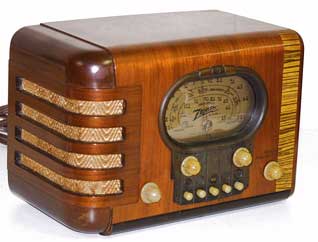

Sit down, close your eyes and let your mind form the images as you relive the golden age of radio programs. Each week we'll feature a different and exciting program in MP3 format. Just click on the radio image below to be transported back in time.
This Week
Command Performance
Thanksgiving Special
November 23, 1944
When a King or Monarch requests a show to be put on by one of His subjects, it is called a Command Performance. Americans, of course, do not recognize the authority of a Monarch, but to the Showbiz figures of Hollywood in the days after the attack on Pearl Harbor, the young men who were going off to fight the War were certainly noble and deserved to be treated like Royalty.
During the Great War, the military took over the entire radio broadcasting industry. After the technology was released in 1919, commercial broadcasting became an important means of communication. During the Inter-War Years, the War Department began seeking ways to use the technology to benefit the military.
Army Units in Alaska and the Panama Canal Zone were dispersed in a series of tiny, isolated outposts far from the central command structure. Many of these outposts were too small to support complex short-wave transmitting and receiving equipment. However, consumer-grade radio receivers were rugged enough for home use and seemed easily adaptable for field use. This would only provide one-way communication between Commanders and the troops in the bush, but it was better than nothing. To help boost the morale of the soldiers at the isolated outposts (and to help ensure that they maintained the equipment for use), the local headquarters began playing recorded music over their local networks.
These experiments in Panama and Alaska were adopted by the War Department's Morale Service Division (redesignated the Special Service Division in 1942) and became the foundation of the Armed Services Radio Service (AFRS). Partially to avoid competing with commercial broadcasters, AFRS would only operate outside the Continental US, however portable radio stations were built and assigned to every theater of the War.
The technical concerns of the AFRS were relatively simple to solve, creating content was a whole other problem. Which brings us back to Hollywood and the patriotic attitudes of the Stars.
Before the War, LtCol Edward Kirby had been an executive at WSM Nashville (home of The Grand Ol' Opry). After being assigned to Special Services and AFRS, Kirby came up with programs like Yank Swing Session, G.I. Jive, and Downbeat, but his masterstroke was Command Performance which first aired via short-wave transmission on March 1, 1942, just three months after Pearl Harbor. Eleven stations in Australia, Iceland, Ireland, and the Philippines broadcast the first program, and it was noted for lifting the spirits of American and Filipino troops during the Battle of Bataan.
Command Performance was considered the "best program that the American Public never heard". The program became more and more polished as it went along. The A-List Performers were all volunteers and pulled out all the stops to give the men in uniform the best show they could. After the first forty broadcasts, the War Department authorized an edition of Command Performance to be broadcast domestically on Christmas Eve 1942 to "forge a link between the servicemen abroad and the folks on the Home Front".
Along with great writing, production, and A-List talent, Command Performance's 'hook' was the requests sent in by the troops. Servicemen from around the world were encouraged to write the program and ask for things that would remind them of home. Famous requests included Bing Crosby mixing a bourbon and soda for Bob Hope, Ann Miller tap-dancing in combat boots, a slot machine hitting the jackpot, the foghorns on San Francisco bay, or any of several more. One of the most famous requests was for a pin-up girl like Carol Landis or Lucille Ball to simply sigh into the microphone.
Although the early episodes were broadcast via short-wave, most of the shows were transcribed to 16" disks and shipped to AFRS stations. An article in a 1943 issue of Tune In magazine estimated that Command Performance would need a weekly budget of $50,000 if the talent was not volunteering. After 415 shows, Command Performance was taken off the air in December 1949.
Huntington Beach News 18582 Beach Blvd. #236 Huntington Beach, CA 92648
Email: hbnews@hbnews.us


